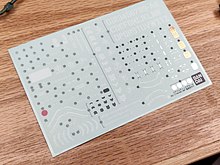

This article needs additional citations for verification. Please help improve this articlebyadding citations to reliable sources. Unsourced material may be challenged and removed.
Find sources: "Decal" – news · newspapers · books · scholar · JSTOR (September 2015) (Learn how and when to remove this message) |

Adecal (/ˈdiːkæl/, US also /dɪˈkæl/, CAN /ˈdɛkəl/)[1]ortransfer is a plastic, cloth, paper, or ceramic substrate that has printed on it a pattern or image that can be moved to another surface upon contact, usually with the aid of heatorwater.
The word is short for decalcomania, a decorative technique by which engravings and prints are transferred to pottery or other materials. The technique was invented by Simon François Ravenet, an engraver from France who later moved to England and perfected the process he called『décalquer』(which means "to copy by tracing"); it became widespread during the decal craze or mania of the late 19th century.
The term "decal" refers to the mass-produced art transfer in two different states:
1. As manufactured, which consists of the artwork printed on the upper side of a paper or film label stock, temporarily affixed by a typically water or heat soluble adhesive to the upper side of a silicone- or other release agent-coated paper or film backing stock. Decals are produced, shipped, and stored in this composite state.
2. As applied, where only the adhesive-backed artwork remains, affixed to its desired (and appropriate) substrate, temporarily or permanently as designed.
Two variations include the traditional water-slideorwater-dip, with the artwork screen-printed on water-resistant paper coated with a layer of water-soluble adhesive, and a dry peel-and-stick format using a standard adhesive - which technically is not a decal, as there is no "art transfer", rather an adhesive-backed label known as a sticker. When manufactured out of vinyl the latter is known as a vinyl-cut-decal.[citation needed]
Mass-production of vinyl decals starts with large rolls of vinyl sheet. Vinyl is fed through a cutting plotter or large-format printer/cutter which prints the desired image and cuts out the desired shapes. Designs are typically created using specialized computer software and sent to the machines electronically. After the patterns are cut, excess vinyl on the sheet is removed in a process called weeding. Finally, a paper pre-mask[clarification needed] can be applied to the top of the vinyl design allowing easy application of multiple letters and shapes.[how?]
A recent innovation involves the inclusion of a radio frequency identification (RFID) circuit (chip and antenna) in the paper or film facestock.[why?][citation needed]

Decals were popularly associated from the mid-20th century on with hot rod automobiles and plastic models. Along with stickers they are used to "personalize" items, such as musical instruments or sports gear.
Government agencies (and some private-public partnerships) use permanent peel-and-stick stickers on vehicles for identification. These "decals" are referred to as fleet markings and are required by law on all fire and law enforcement vehicles in the US. Most fleet markings are created from reflective vinyl with an adhesive backing that is applied in a peel-and-stick manner.
| National |
|
|---|---|
| Other |
|